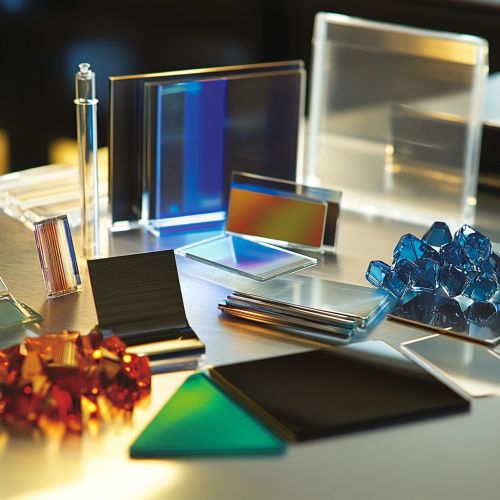Smart Materials: Science and Applications: Difference between revisions
(Created page with "== Introduction == Smart materials, also known as intelligent or responsive materials, are materials that have the ability to change their properties in response to external stimuli such as temperature, pressure, electric or magnetic fields, light, or chemical environments. These materials have garnered significant attention in recent years due to their potential applications across various fields, including aerospace, biomedical engineering, electronics, and robotics....") |
No edit summary |
||
| Line 31: | Line 31: | ||
Self-healing materials have the ability to repair damage autonomously without external intervention. These materials are designed to mimic biological healing processes and are used in coatings, composites, and polymers. [[Microencapsulation|Microencapsulation]] and [[Diels-Alder Reaction|Diels-Alder reactions]] are common mechanisms employed in self-healing materials. | Self-healing materials have the ability to repair damage autonomously without external intervention. These materials are designed to mimic biological healing processes and are used in coatings, composites, and polymers. [[Microencapsulation|Microencapsulation]] and [[Diels-Alder Reaction|Diels-Alder reactions]] are common mechanisms employed in self-healing materials. | ||
[[Image:Detail-104461.jpg|thumb|center|A collection of various smart materials, including piezoelectric crystals, shape memory alloys, and electrochromic panels, displayed on a laboratory table.|class=only_on_mobile]] | |||
[[Image:Detail-104462.jpg|thumb|center|A collection of various smart materials, including piezoelectric crystals, shape memory alloys, and electrochromic panels, displayed on a laboratory table.|class=only_on_desktop]] | |||
== Mechanisms of Smart Materials == | == Mechanisms of Smart Materials == | ||
Latest revision as of 13:05, 23 November 2024
Introduction
Smart materials, also known as intelligent or responsive materials, are materials that have the ability to change their properties in response to external stimuli such as temperature, pressure, electric or magnetic fields, light, or chemical environments. These materials have garnered significant attention in recent years due to their potential applications across various fields, including aerospace, biomedical engineering, electronics, and robotics. This article delves into the science behind smart materials, exploring their types, mechanisms, and applications.
Types of Smart Materials
Smart materials can be broadly categorized into several types based on their responsive properties. Each type exhibits unique characteristics and mechanisms that enable them to respond to specific stimuli.
Piezoelectric Materials
Piezoelectric materials generate an electric charge in response to mechanical stress. This property is reversible, meaning they can also deform when subjected to an electric field. Common piezoelectric materials include quartz, lead zirconate titanate (PZT), and polyvinylidene fluoride (PVDF). These materials are widely used in sensors, actuators, and energy harvesting devices.
Shape Memory Alloys (SMAs)
Shape memory alloys are metals that can return to a predefined shape when heated above a certain temperature. The most well-known SMA is nitinol, an alloy of nickel and titanium. SMAs are utilized in applications such as medical stents, actuators, and adaptive structures due to their ability to undergo large deformations and recover their original shape.
Electrochromic Materials
Electrochromic materials change their optical properties, such as color or transparency, in response to an applied electric field. These materials are used in applications like smart windows, displays, and mirrors. Tungsten trioxide is a commonly used electrochromic material.
Magnetorheological and Electrorheological Fluids
Magnetorheological (MR) and electrorheological (ER) fluids are smart fluids that change their viscosity in the presence of a magnetic or electric field, respectively. These fluids are used in damping systems, clutches, and prosthetics. MR fluids typically consist of micron-sized iron particles suspended in a carrier fluid, while ER fluids contain dielectric particles suspended in an insulating oil.
Thermochromic Materials
Thermochromic materials change color in response to temperature changes. These materials are used in applications such as temperature sensors, mood rings, and thermometers. Leuco dyes are a common type of thermochromic material.
Self-Healing Materials
Self-healing materials have the ability to repair damage autonomously without external intervention. These materials are designed to mimic biological healing processes and are used in coatings, composites, and polymers. Microencapsulation and Diels-Alder reactions are common mechanisms employed in self-healing materials.


Mechanisms of Smart Materials
The functionality of smart materials is governed by various mechanisms that enable them to respond to external stimuli. Understanding these mechanisms is crucial for the development and optimization of smart materials for specific applications.
Piezoelectric Effect
The piezoelectric effect is the generation of electric charge in response to mechanical stress. This phenomenon occurs due to the displacement of ions within the crystal lattice of piezoelectric materials, resulting in a polarization of charge. The reverse piezoelectric effect, where an applied electric field induces mechanical deformation, is also utilized in various applications.
Shape Memory Effect
The shape memory effect in SMAs is attributed to a reversible phase transformation between martensite and austenite phases. At lower temperatures, the material exists in the martensitic phase, which can be deformed. Upon heating, the material transforms to the austenitic phase, recovering its original shape. This transformation is driven by changes in the crystal structure of the alloy.
Electrochromism
Electrochromism involves the reversible change in optical properties of a material due to the insertion or extraction of ions and electrons. This process alters the electronic structure of the material, leading to changes in color or transparency. Electrochromic devices typically consist of an electrochromic layer, an electrolyte, and a counter electrode.
Magnetorheological and Electrorheological Effects
MR and ER fluids exhibit changes in viscosity due to the alignment of particles within the fluid under the influence of a magnetic or electric field. In MR fluids, the iron particles form chain-like structures that increase the fluid's resistance to flow. Similarly, in ER fluids, the dielectric particles align to form structures that enhance the fluid's viscosity.
Thermochromism
Thermochromism involves a change in color due to a temperature-induced alteration in the material's molecular structure or phase. This can occur through various mechanisms, such as changes in the conjugation of molecular bonds or phase transitions in liquid crystals.
Self-Healing Mechanisms
Self-healing materials employ various mechanisms to repair damage. Microencapsulation involves the release of healing agents from microcapsules embedded within the material upon damage. The Diels-Alder reaction is a reversible chemical reaction that enables the reformation of bonds in polymers, facilitating self-repair.
Applications of Smart Materials
Smart materials have found applications across a wide range of industries due to their unique properties and responsiveness to external stimuli.
Aerospace and Defense
In aerospace and defense, smart materials are used for vibration control, noise reduction, and adaptive structures. Piezoelectric materials are employed in sensors and actuators for structural health monitoring, while SMAs are used in morphing wings and deployable structures.
Biomedical Engineering
In biomedical engineering, smart materials are utilized for drug delivery systems, tissue engineering, and medical devices. SMAs are used in stents and orthodontic wires, while self-healing materials are explored for wound healing applications.
Electronics and Optoelectronics
Smart materials are integral to the development of flexible electronics, displays, and sensors. Electrochromic materials are used in smart windows and displays, while piezoelectric materials are employed in energy harvesting devices and sensors.
Robotics and Automation
In robotics and automation, smart materials are used for actuators, sensors, and adaptive systems. MR and ER fluids are employed in robotic joints and prosthetics for variable stiffness and damping control.
Construction and Architecture
Smart materials are used in construction and architecture for energy-efficient buildings and adaptive structures. Thermochromic materials are used in smart windows for temperature regulation, while self-healing materials are explored for durable coatings and concrete.
Challenges and Future Directions
Despite the promising applications of smart materials, several challenges remain in their development and commercialization. These include the scalability of manufacturing processes, the durability and reliability of smart materials, and the integration of smart materials into existing systems.
Future research in smart materials is focused on developing new materials with enhanced properties, improving the understanding of underlying mechanisms, and exploring novel applications. Advances in nanotechnology, materials science, and computational modeling are expected to drive the development of next-generation smart materials.
